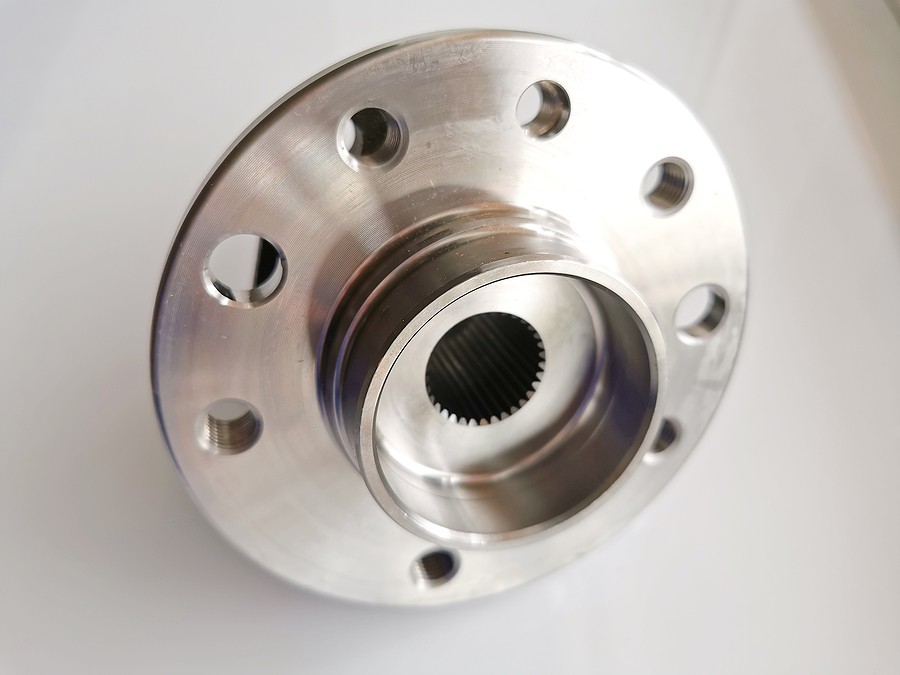Wheel bearings are essential to the operation of your car and the high-performing qualities. More importantly, the wheel bearings are crucial for the optimal working of the tire, tire, and wheel assemblies to work in tandem for proper performance. The wheel bearing is in charge of allowing for friction-free movement and rotation, providing smooth tire glide on the roads. There are different types of wheel bearings – because of this, it can change how long it takes to replace a wheel bearing.
Symptoms of Bad Front and Rear Wheel Bearings
As we know by now, the wheel bearings are key parts of your car that are used in both the front and back of your vehicle, placed on the front and back wheels. Each individual wheel has its own wheel bearing, meaning it is possible for just one wheel bearing to wear-down over time or become more damaged than the other three options. It is possible for one wheel bearing to wear out while the others are in good condition, which can change the time of how long it takes to replace a wheel bearing.
A singular wheel bearing replacement is the reason why you don’t necessarily have to replace every wheel bearings during a visit to the local mechanic. Many mechanics might try to get you to do all four at the same time so they can make some extra money on the procedure and the labor cost, but this is usually not necessary and just a way for them to get more money at one time. Ensure when the mechanic is doing the procedure that you ask how long it takes to replace a wheel bearing.
There are certain signs and symptoms you can keep an eye and ear out for to indicate the prevalence of bad wheel bearings on your car. If you don’t know the signs and symptoms, the mechanic will know what to look out for and can let you know how long it takes to replace a wheel bearing. To give you an idea of what to look for, we have included the top 5 bad wheel bearing symptoms.
-
Uneven Tire Wear
Uneven tire wear can be a very common occurrence, either due to excessive driving, driving on uneven and bumpy terrain, certain driving characteristics, or the bad wheel alignment. When wheel bearings wear down over time, they tend to wear out unevenly from the other tires and wheels. This occurrence of the worn-down bearings can cause the tires to have abnormal wear, making of an uncomfortable and shaky ride.
In a typical driving situation, when your tires wear down and wear out, they would all be worn out from the same time just from typical driving use. If the tires are unevenly worn out and are not evenly worn, it could be due to a bad wheel bearing. If just one wheel bearing is at fault, this can influence how long it takes to replace a wheel bearing.
In addition, other issues can cause the wheel bearing break-down and uneven wear on tires, such as poor wheel alignment, unbalanced tires, and risky driving behavior.
-
Grinding Noise
Another common symptom of bad wheel bearings, ora poor wheel bearing, is that your tires make a loud grinding noise while using. The grinding noise location can indicate which wheel bearing is damaged and can let you know how long it takes to replace a wheel bearing. The grinding noise typically happens when the wheel bearing loses the lubrication and builds up too much heat, causing excessive friction and internal heat.
The grinding noise can occur from two pieces, usually metal on metal, grinding together and causing excessive friction in the wheel area. Typically, you might only hear this sound coming from a singular wheel due to the wheel bearings’ uneven wear. If you notice the loud noises while shifting gears or turning the steering wheel, then this could be a clear sign that the wheel bearings are damaged, and you need to look into how long it takes to replace a wheel bearing.
-
Steering Wheel Vibrates
If the wheel bearings have severely deteriorated over time, you will notice an excessive vibration and shake in the steering wheel while driving. You might notice this shaking and vibrations while you are driving at slower speeds, but the problem will increase when you try to accelerate your car, whether driving at highway speeds, towing heavy loads, or driving uphill.
Many people might assume that this symptom has to do with unbalanced tires on your vehicle, but you should bring your car to a mechanic to have them diagnose the issue and make sure that the wheel bearings and the tires are at fault. In order to determine if the shaking is due to wheel bearings, the mechanic might suggest a replacement, which can lead you to ask how long it takes to replace a wheel bearing.
-
Vehicle Pulls To One Side
When your wheel bearings have worn down over time due to prolonged use or tough driving conditions, they can become corroded or pitted. If the smooth lining on the wheel bearings breaks down and is no longer there, the bearings’ rough surface causesthe vibration in the vehicle. When this is the case, you need to look into how long it takes to replace a wheel bearing.
You might also experience your car pulling to one side when you are attempting to drive in a straight line on the road. This can be even more prevalent when you are pressing on the brakes, as the car will drive to one side unintendedly. Although this is a common sign that something is wrong with your brake rotors or calipers, the actual root cause of the issue could be the wheel bearings themselves. If the mechanic determines this is the cause of the pulling, you need to look into how long it takes to replace a wheel bearing at your local auto body shop.
-
Excess Wheel Wobble
Although this excess play in the wheels is a bit more tedious and difficult to diagnose in your car, it still needs to be ruled out when looking at your car’s wheel bearings To diagnose this issue, you should bring your car to a professional so they can lift your car on a hydraulic lift or on the jack stands to access the underside of your vehicle.
When the car is lifted off of the ground, the mechanic will need to grab one of the wheels and rock it back and forth to see how much movement is present in the wheel. The mechanic should repeat this process to each wheel on the other axle to determine how long the wheel bearing(s) replacement will take.
If the wheel wobbles or moves too much when the mechanic shakes the wheel, this most likely points to the bad wheel bearings being the wheel wobble’s culprit. If this is the case, you need to ask the mechanic how long it takes to replace a wheel bearing at his shop.
Cost To Replace Wheel Bearings
When you decide that the wheel bearings are causing issues in your car, you might decide that you need to look up how long it takes to replace a wheel bearing. In this situation, it is also crucial to look up the total price of a replacement for each type of wheel bearing on your vehicle.
-
Front Wheel Bearings
Front-wheel bearings are connected to the steering knuckle arm assembly and the axle components in your car, showing how they are key parts to your vehicle’s functioning. These bearings are built to last multiple years without the need to be replaced, but certain conditions can cause these front wheel bearings to break down over time. The cost to replace both front wheel bearings ranges between $260 and $480 and can influence how long it takes to replace a wheel bearing.
Looking at the breakdown of prices for the front wheel bearings, the parts alone for this fix comes to an average of $120 and $200. In addition, the labor is even more expensive than the cost of the parts, coming in between $140 and $280. The exact cost of the labor will depend on where you take your car, the type of shop you bring your vehicle to, and the geographical location of the shop.
If you are just looking to replace one side of the wheel bearing, then these costs will just be split in half for the total single front wheel bearing replacement price. The cost of a single replacement ranges between $130 and $220, with the parts coming in at $60-$100, and the price of the labor averaging between $70 and $140.
-
Rear Wheel Bearings
Compared to the front wheel bearings, the rear wheel bearings are cheaper to replace and take less time when regarding how long it takes to replace a wheel bearing. However, this fix’s price depends on the make and model of the car that needs replacing. The complete rear wheel bearing replacement cost usually ranges between $240 and $460 and can affect how long it takes to replace a wheel bearing. The total cost of the parts ranges between $100 and $!80, while the total labor cost is between $140 and $280.
If you just need a rear wheel bearing replacement on one side, you just half cut these costs in half, coming in between $120 and $240 for the complete job, with $50-$90 for the parts and $70 $140 for the labor. The decision of whether to replace one set of wheel bearings or the complete set can affect how long it takes to replace a wheel bearing.
-
Rear Hub Bearings
Some types of vehicles use a rear hub mechanism instead of the front wheel bearings. In this system, the wheel bearings are packed in the hub and installed as a singular complete unit instead of separate components, which can influence how long it takes to replace a wheel bearing. In addition to influencing how long it can take to replace the wheel bearing, this makes the hub assembly more expensive than just replacing the hubs. For this, you can expect to pay between $400 and $800 to replace both assemblies.
Types of Wheel Bearings
There are different types of wheel bearings that you should keep in mind. There are common types that you will typically find on your car –
-
Ball Bearings
Ball bearings are the most common type of wheel bearing and the most versatile that are on the market today. This type of wheel bearings is able to absorb different types of loads for shock absorption and adequate performance capabilities. To determine the cornering pressure that the ball bearings can utilize, you need to determine the thrust load and the radial load to see how long it will take to replace this type of wheel bearing.
-
Precision Ball Bearings
This type of wheel bearing is used for high-performance vehicles and needs, altering how long it takes to replace a wheel bearing. These precision ball bearings have the ability to reduce friction and the excess heat created by materials rubbing together. The rotation speed in the precision ball bearings is higher than regular bearings, being extensively used for thrust and radial loads in vehicles.
-
Roller Bearings
Roller bearings are a specific type of wheel bearings that you can usually find on various types of cars in the market. The only downside to using this type of wheel bearing is that they are not as versatile as typical ball bearings, but they are great at handling heavyweights. This characteristic of roller bearings can alter how long it takes to replace a wheel bearing.
Tapered Roller Bearings
The regular wheels in your vehicles will have tapered roller bearings that cut down on the friction, excess movement, rubbing, and the heat in your vehicle when there is a higher thrust load. As you turn your car, the tapered roller bearings prevent grinding in the parts and affect how long it takes to replace your wheel bearing.
Conclusion
As we know now, the wheel bearings are key components of your car that are essential in your vehicle’s proper operation, function, and performance. Since the wheel bearings are crucial for the functioning of the tire and wheel assemblies, they must be properly changed and replaced on time. In addition there are different kinds of wheel bearings that you have in your vehicle, changing how long it takes to replace a wheel bearing.



